Cardiganshire: Difference between revisions
| (20 intermediate revisions by 5 users not shown) | |||
| Line 1: | Line 1: | ||
{{Infobox county | {{Infobox county | ||
|name=Cardiganshire | |name=Cardiganshire | ||
|welsh=Sir Aberteifi | |welsh=Sir Aberteifi ''or'' Ceredigion | ||
|map image= | |map image=Cardiganshire Brit Isles Sect 6.svg | ||
|picture=Aberystwyth from Constitution hill 1.JPG | |picture=Aberystwyth from Constitution hill 1.JPG | ||
|picture caption=Aberystwyth | |picture caption=Aberystwyth | ||
|county town=Cardigan | |||
|county town= | |||
}} | }} | ||
The '''County of Cardigan''' is a costal [[Counties of the United Kingdom|shire]] on the west coast of Wales, bounded on the west by [[Cardigan Bay]], part of the [[Irish Sea]], but away from the county's narrow coastal plain Cardiganshire rises up into mountains. | |||
==The lie of the land== | |||
Cardiganshire curves along the coast of Cardigan Bay, part of the [[Irish Sea]], a coast marked by fine, sandy beaches and rugged cliffs. Inland it rises into gentle farming country and river valleys, rising up to the dramatic west slopes of the Cambrian Mountains. | |||
The Cardiganshire coast in the north ends at the [[River Dovey]], across which lies [[Merionethshire]], and in the south it ends at the [[River Teifi]], beyond which lies [[Pembrokeshire]]. In the mountains to the east are [[Montgomeryshire]], [[Radnorshire]] and [[Brecknockshire]], and to the south of Cardiganshire is [[Carmarthenshire]]. | |||
The [[Cambrian Mountains]] cover much of the east of the county. In the south and west the surface is less elevated. The highest point is [[Plynlimon]] at 2,467 | The [[Cambrian Mountains]] cover much of the east of the county; this large area forms part of the desert of Wales. In the south and west, the surface is less elevated. The highest point is [[Plynlimon]] at 2,467 feet, where five rivers have their source: the [[River Severn|Severn]], the [[River Wye|Wye]], the [[River Dulas, Cardiganshire|Dulas]], the [[River Llyfnant|Llyfnant]] and the [[River Rheidol|Rheidol]], the last of which meets the [[River Mynach]] in a 300-foot plunge at the [[Devil's Bridge]] chasm. | ||
Along with [[Pembrokeshire]] and [[Cornwall]], Cardiganshire's | The 50 miles of coastline have many sandy beaches with clear sea water of high quality. Along with [[Pembrokeshire]] and [[Cornwall]], Cardiganshire's coast boasts some of the whitest sand beaches and cleanest, clearest, turquoise seas in the [[United Kingdom]], particularly the coast from [[New Quay]] to [[Aberporth]], mainly due to the fact that the Cardigan Bay coast has virtually no industrial discharge. As a result, off Cardiganshire is the only permanent summer residence of bottle-nosed dolphins in the United Kingdom. | ||
Coursing towards this coast are several rivers and brooks. The largest river is the [[River Teifi]] which forms the border with Carmarthenshire and Pembrokeshire for much of its length. Other significant rivers include the [[River Aeron]] which has its estuary at [[Aberaeron]], the [[River Ystwyth]] and the [[River Rheidol]] both of which reach the sea in [[Aberystwyth]] harbour. | |||
Tourism and agriculture, chiefly hill farming, are the most important industries. In addition, two universities are within the county boundaries: Aberystwyth University and the Lampeter campus of the University of Wales, Trinity Saint David. The National Library of Wales, which was founded in 1907, is located in Aberystwyth. | |||
The county lacks any large commercial areas. The nearest substantial settlements are located at least 1 hour 45 minutes drive away. From Cardiganshire's largest town, [[Aberystwyth]], the nearest sizeable commercial towns are [[Swansea]] in [[Glamorgan]], 75 miles to the south, [[Shrewsbury]] in [[Shropshire]] 76 miles to the east and [[Wrexham]] in [[Denbighshire]] 82 miles to the northeast. | |||
Dylan Thomas lived for a time in New Quay and in Talsarn and he frequented Aberaeron and Lampeter. The Dylan Thomas Trail runs through part of Cardiganshire, linking the places associated with the poet.<ref>''The Dylan Thomas Trail'' by D. N. Thomas, Y. Lolfa 2002</ref> | |||
==Towns and villages== | ==Towns and villages== | ||
*[[Cardigan]] | [[File:Tregaron Market Place.jpg|right|thumb|200px|Tregaron]] | ||
[[File:Aberaeron Harbour - geograph.org.uk - 576283.jpg|right|thumb|200px|Aberaeron]] | |||
[[File:Llanddewi-Brefi Village - The New Inn.jpg|right|thumb|200px|Llanddewi-Brefi]] | |||
Cardiganshire is a county of small villages. The towns are modest; Aberytwyth stands out as a confident town and Cardigan though not large has the bustle of a small, satisfied market town. The main towns in the county are: | |||
*[[Cardigan]] ''([[county town]], partly in Pembrokeshire)'' | |||
*[[Aberystwyth]] | *[[Aberystwyth]] | ||
*[[Lampeter]] | *[[Lampeter]] | ||
| Line 27: | Line 38: | ||
*[[Tregaron]] | *[[Tregaron]] | ||
==Parishes== | ===Parishes=== | ||
{{parishliststart}} | {{parishliststart}} | ||
*[[Aberaeron]] | *[[Aberaeron]] | ||
*[[Aberporth]] | *[[Aberporth]] | ||
*[[Aberteifi]] | *[[Cardigan|Aberteifi]] | ||
*[[Aberystwyth]] | *[[Aberystwyth]] | ||
*[[Beulah]] | *[[Beulah]] | ||
| Line 43: | Line 54: | ||
*[[Henfynyw]] | *[[Henfynyw]] | ||
*[[Lampeter]] | *[[Lampeter]] | ||
*[[Llanarth]] | *[[Llanarth, Cardiganshire|Llanarth]] | ||
*[[Llanbadarn Fawr]] | *[[Llanbadarn Fawr, Cardiganshire|Llanbadarn Fawr]] | ||
*[[ | *[[Llanddewi Brefi]] | ||
*[[Llandyfriog]] | *[[Llandyfriog]] | ||
*[[Llandysiliogogo]] | *[[Llandysiliogogo]] | ||
| Line 56: | Line 67: | ||
*[[Llangrannog]] | *[[Llangrannog]] | ||
*[[Llangwyryfon]] | *[[Llangwyryfon]] | ||
*[[Llangybi]] | *[[Llangybi, Cardiganshire|Llangybi]] | ||
*[[Llangynfelyn]] | *[[Llangynfelyn]] | ||
*[[Llanilar]] | *[[Llanilar]] | ||
| Line 82: | Line 93: | ||
{{parishlistend}} | {{parishlistend}} | ||
{{ | == History == | ||
The name of the county comes from the ancient Kingdom of ''Ceredigion'', which means ''Land of Ceredig'', who was a son of Cunedda, a chieftain who re-conquered much of western Britain from the Irish in the 5th century. It remained a kingdom ruled by Ceredig's descendants until it expanded and changed its name, first to Seisyllwg in the late 7th century and, after the union of Seisyllwg with Dyfed, it was incorporated into Deheubarth in the mid 10th century. | |||
There is evidence to show that the erstwhile kingdom was made shire ground between 1270 and 1280, and following the Edwardian Conquest of Wales, it was formalised by the Statute of Rhuddlan in 1284. The name ''Cardigan'' was an Anglicisation of the name for ''Ceredigion''. | |||
==Language== | |||
Cardiganshire is mainly Welsh-speaking; in its population some 52% spoke Welsh at the 2001 census. In 1991 the number was 59.1%. | |||
Non-Welsh speakers tend to be more concentrated in and around the two university towns and along the coast, for example in [[Borth]] only 40% of the population was born in Wales and 36% of residents are Welsh-speaking. | |||
==Things to see in Cardiganshire== | |||
[[File:Devil's Bridge - geograph.org.uk - 196947.jpg|right|thumb|180px|Devil's Bridge]] | |||
{{UKPlacesKey|W}} | |||
*{{i-Castle}} [[Aberystwyth Castle]] | |||
*[[Aberystwyth Electric Cliff Railway]] | |||
*Cwmystwyth Mines | |||
*[[Devil's Bridge]] | |||
*[[Hafod Uchtryd]] | |||
*[[Llanerchaeron]] | |||
*{{i-House}} [[Nanteos Mansion]] | |||
*{{i-Abbey}} [[Strata Florida Abbey]] | |||
*[[Trawsgoed]] | |||
*[[Vale of Rheidol Railway]] | |||
*{{i-MuseumNotFree}} Welsh Gold Centre, [[Tregaron]] | |||
*National Library of Wales, [[Aberystwyth]] | |||
==See also== | |||
*[[Flag of Cardiganshire]] | |||
==References== | |||
{{reflist}} | |||
==Outside links == | |||
*[http://tourism.ceredigion.gov.uk/ Tourist Information] | |||
*[http://www.visitwales.co.uk/ Tourist Information from the Welsh Assembly Government] | |||
{{British county}} | {{British county}} | ||
Latest revision as of 19:11, 25 June 2024
| Cardiganshire Welsh: Sir Aberteifi or Ceredigion United Kingdom | |
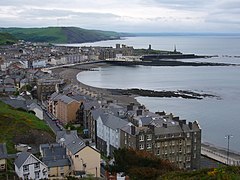 Aberystwyth | |
|---|---|
| Golud Gwlad Rhyddid (A nation's wealth is freedom) | |
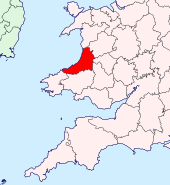
| |
| [Interactive map] | |
| Area: | 693 square miles |
| Population: | 75,784 |
| County town: | Cardigan |
| County flower: | Bog-rosemary [1] |
The County of Cardigan is a costal shire on the west coast of Wales, bounded on the west by Cardigan Bay, part of the Irish Sea, but away from the county's narrow coastal plain Cardiganshire rises up into mountains.
The lie of the land
Cardiganshire curves along the coast of Cardigan Bay, part of the Irish Sea, a coast marked by fine, sandy beaches and rugged cliffs. Inland it rises into gentle farming country and river valleys, rising up to the dramatic west slopes of the Cambrian Mountains.
The Cardiganshire coast in the north ends at the River Dovey, across which lies Merionethshire, and in the south it ends at the River Teifi, beyond which lies Pembrokeshire. In the mountains to the east are Montgomeryshire, Radnorshire and Brecknockshire, and to the south of Cardiganshire is Carmarthenshire.
The Cambrian Mountains cover much of the east of the county; this large area forms part of the desert of Wales. In the south and west, the surface is less elevated. The highest point is Plynlimon at 2,467 feet, where five rivers have their source: the Severn, the Wye, the Dulas, the Llyfnant and the Rheidol, the last of which meets the River Mynach in a 300-foot plunge at the Devil's Bridge chasm.
The 50 miles of coastline have many sandy beaches with clear sea water of high quality. Along with Pembrokeshire and Cornwall, Cardiganshire's coast boasts some of the whitest sand beaches and cleanest, clearest, turquoise seas in the United Kingdom, particularly the coast from New Quay to Aberporth, mainly due to the fact that the Cardigan Bay coast has virtually no industrial discharge. As a result, off Cardiganshire is the only permanent summer residence of bottle-nosed dolphins in the United Kingdom.
Coursing towards this coast are several rivers and brooks. The largest river is the River Teifi which forms the border with Carmarthenshire and Pembrokeshire for much of its length. Other significant rivers include the River Aeron which has its estuary at Aberaeron, the River Ystwyth and the River Rheidol both of which reach the sea in Aberystwyth harbour.
Tourism and agriculture, chiefly hill farming, are the most important industries. In addition, two universities are within the county boundaries: Aberystwyth University and the Lampeter campus of the University of Wales, Trinity Saint David. The National Library of Wales, which was founded in 1907, is located in Aberystwyth.
The county lacks any large commercial areas. The nearest substantial settlements are located at least 1 hour 45 minutes drive away. From Cardiganshire's largest town, Aberystwyth, the nearest sizeable commercial towns are Swansea in Glamorgan, 75 miles to the south, Shrewsbury in Shropshire 76 miles to the east and Wrexham in Denbighshire 82 miles to the northeast.
Dylan Thomas lived for a time in New Quay and in Talsarn and he frequented Aberaeron and Lampeter. The Dylan Thomas Trail runs through part of Cardiganshire, linking the places associated with the poet.[1]
Towns and villages
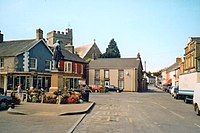
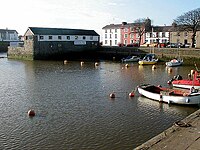
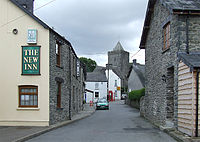
Cardiganshire is a county of small villages. The towns are modest; Aberytwyth stands out as a confident town and Cardigan though not large has the bustle of a small, satisfied market town. The main towns in the county are:
- Cardigan (county town, partly in Pembrokeshire)
- Aberystwyth
- Lampeter
- New Quay
- Tregaron
Parishes
- Aberaeron
- Aberporth
- Aberteifi
- Aberystwyth
- Beulah
- Blaenrheidol
- Borth
- Ceulanamaesmawr
- Ciliau Aeron
- Dyffryn Arth
- Faenor
- Geneu'r Glyn
- Henfynyw
- Lampeter
- Llanarth
- Llanbadarn Fawr
- Llanddewi Brefi
- Llandyfriog
- Llandysiliogogo
- Llandysul
- Llanfair Clydogau
- Llanfarian
- Llanfihangel Ystrad
- Llangeitho
- Llangoedmor
- Llangrannog
- Llangwyryfon
- Llangybi
- Llangynfelyn
- Llanilar
- Llanllwchaiarn
- Llanrhystyd
- Llansantffraed
- Llanwenog
- Llanwnnen
- Lledrod
- Melindwr
- Nantcwnlle
- New Quay
- Penbryn
- Pontarfynach
- Tirymynach
- Trawsgoed
- Trefeurig
- Tregaron
- Troedyraur
- Y Ferwig
- Ysbyty Ystwyth
- Ysgubor-y-coed
- Ystrad Fflur
- Ystradmeurig
History
The name of the county comes from the ancient Kingdom of Ceredigion, which means Land of Ceredig, who was a son of Cunedda, a chieftain who re-conquered much of western Britain from the Irish in the 5th century. It remained a kingdom ruled by Ceredig's descendants until it expanded and changed its name, first to Seisyllwg in the late 7th century and, after the union of Seisyllwg with Dyfed, it was incorporated into Deheubarth in the mid 10th century.
There is evidence to show that the erstwhile kingdom was made shire ground between 1270 and 1280, and following the Edwardian Conquest of Wales, it was formalised by the Statute of Rhuddlan in 1284. The name Cardigan was an Anglicisation of the name for Ceredigion.
Language
Cardiganshire is mainly Welsh-speaking; in its population some 52% spoke Welsh at the 2001 census. In 1991 the number was 59.1%.
Non-Welsh speakers tend to be more concentrated in and around the two university towns and along the coast, for example in Borth only 40% of the population was born in Wales and 36% of residents are Welsh-speaking.
Things to see in Cardiganshire
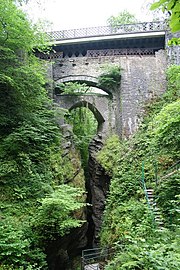
| Key | |
| Cathedral/Abbey/Priory | |
| Accessible open space | |
| Amusement/Theme Park | |
| Castle | |
| Country Park | |
| Cadw | |
| Forestry Commission | |
| Heritage railway | |
| Historic House | |
| Museum (free/not free) | |
| National Trust | |
| Zoo | |
 Aberystwyth Castle
Aberystwyth Castle- Aberystwyth Electric Cliff Railway
- Cwmystwyth Mines
- Devil's Bridge
- Hafod Uchtryd
- Llanerchaeron
 Nanteos Mansion
Nanteos Mansion Strata Florida Abbey
Strata Florida Abbey- Trawsgoed
- Vale of Rheidol Railway
 Welsh Gold Centre, Tregaron
Welsh Gold Centre, Tregaron- National Library of Wales, Aberystwyth
See also
References
- ↑ The Dylan Thomas Trail by D. N. Thomas, Y. Lolfa 2002
Outside links
| Counties of the United Kingdom |
|---|
|
Aberdeen • Anglesey • Angus • Antrim • Argyll • Armagh • Ayr • Banff • Bedford • Berks • Berwick • Brecknock • Buckingham • Bute • Caernarfon • Caithness • Cambridge • Cardigan • Carmarthen • Chester • Clackmannan • Cornwall • Cromarty • Cumberland • Denbigh • Derby • Devon • Dorset • Down • Dumfries • Dunbarton • Durham • East Lothian • Essex • Fermanagh • Fife • Flint • Glamorgan • Gloucester • Hants • Hereford • Hertford • Huntingdon • Inverness • Kent • Kincardine • Kinross • Kirkcudbright • Lanark • Lancaster • Leicester • Lincoln • Londonderry • Merioneth • Middlesex • Midlothian • Monmouth • Montgomery • Moray • Nairn • Norfolk • Northampton • Northumberland • Nottingham • Orkney • Oxford • Peebles • Pembroke • Perth • Radnor • Renfrew • Ross • Roxburgh • Rutland • Selkirk • Shetland • Salop • Somerset • Stafford • Stirling • Suffolk • Surrey • Sussex • Sutherland • Tyrone • Warwick • West Lothian • Westmorland • Wigtown • Wilts • Worcester • York |